Topseller
-
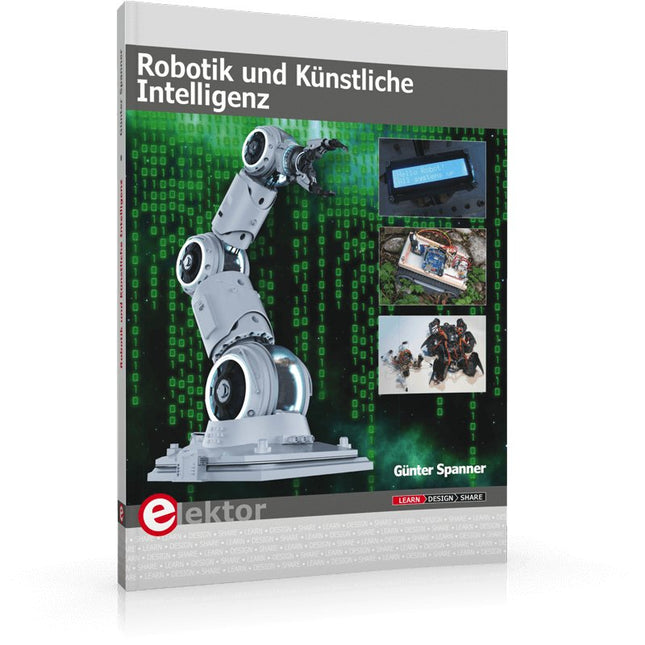
Elektor Publishing Robotik und Künstliche Intelligenz
Dieses Buch ist eine Einführung in das hochaktuelle Gebiet der Robotik. Dabei stehen praktische Anwendungsbeispiele im Vordergrund. Neben den technischen und mechanischen Grundlagen werden die elektronischen Komponenten und Module erläutert. Eine zentrale Rolle spielt dabei der Mikrocontroller. Für Robotik-Anwendungen haben sich zwei Controller-Boards etabliert: der Arduino und der Raspberry Pi. Dem trägt dieses Buch Rechnung und beschreibt praktische Nachbauprojekte mit diesen beiden populären Boards. Getreu der Philosophie des „Learning by Doing“ können sich auch ambitionierte, nichtprofessionelle Anwender mit dem Lernmaterial des Buches einen Überblick über den neuesten Stand der Robotertechnik und KI verschaffen. Für praktische Anwendungen können sowohl komplette Bausätze als auch einzelne Komponenten verwendet werden. Dabei wurde stets darauf geachtet, dass die Hardware möglichst universell einsetzbar ist.
€ 39,80
Mitglieder identisch
-

Espressif ESP-C3-12F-Kit Entwicklungsboard mit integriertem 4 MB Flash
Der ESP32-C3-Chip verfügt über branchenführende Leistung bei geringem Stromverbrauch und Hochfrequenzleistung und unterstützt das Wi-Fi IEEE802.11b/g/n-Protokoll und BLE 5.0. Der Chip ist mit einem RISC-V 32-Bit-Single-Core-Prozessor mit einer Arbeitsfrequenz von bis zu 160 MHz ausgestattet. Unterstützen Sie die Sekundärentwicklung, ohne andere Mikrocontroller oder Prozessoren zu verwenden. Der Chip verfügt über integriertes 400 KB SRAM, 384 KB ROM, 8 KB RTC SRAM, integrierter 4 MB Flash unterstützt auch externen Flash. Der Chip unterstützt eine Vielzahl von Arbeitszuständen mit geringem Stromverbrauch, die den Stromverbrauchsanforderungen verschiedener Anwendungsszenarien gerecht werden können. Durch die einzigartigen Funktionen des Chips wie die Feintakt-Gating-Funktion, die Funktion zur dynamischen Anpassung der Spannungstaktfrequenz und die Funktion zur Anpassung der HF-Ausgangsleistung kann das beste Gleichgewicht zwischen Kommunikationsentfernung, Kommunikationsrate und Stromverbrauch erzielt werden. Das ESP-C3-12F-Modul bietet eine Fülle von Peripherieschnittstellen, darunter UART, PWM, SPI, I²S, I²C, ADC, Temperatursensor und bis zu 15 GPIOs. Merkmale Unterstützt Wi-Fi 802.11b/g/n, 1T1R-Modus-Datenrate bis zu 150 Mbit/s Unterstützt BLE5.0, unterstützt kein klassisches Bluetooth, Ratenunterstützung: 125 Kbit/s, 500 Kbit/s, 1 Mbit/s, 2 Mbit/s RISC-V 32-Bit-Single-Core-Prozessor, unterstützt eine Taktfrequenz von bis zu 160 MHz, verfügt über 400 KB SRAM, 384 KB ROM, 8 KB RTC SRAM Unterstützt UART/PWM/GPIO/ADC/I²C/I²S-Schnittstelle, unterstützt Temperatursensor, Impulszähler Die Entwicklungsplatine verfügt über RGB-Drei-in-Eins-Lampenperlen, was für die zweite Entwicklung von Kunden praktisch ist. Unterstützt mehrere Schlafmodi, der Tiefschlafstrom beträgt weniger als 5 uA Serielle Portrate bis zu 5 Mbit/s Unterstützt den STA/AP/STA+AP-Modus und den Promiscuous-Modus Unterstützt Smart Config (APP)/AirKiss (WeChat) von Android und iOS, Netzwerkkonfiguration mit einem Klick Unterstützt lokales Upgrade der seriellen Schnittstelle und Remote-Firmware-Upgrade (FOTA) Allgemeine AT-Befehle können schnell verwendet werden Unterstützt sekundäre Entwicklung, integrierte Windows- und Linux-Entwicklungsumgebung Über die Flash-Konfiguration ESP-C3-12F nutzt standardmäßig den integrierten 4 MB Flash des Chips und unterstützt die externe Flash-Version des Chips.
€ 14,95€ 7,50
Mitglieder identisch
-
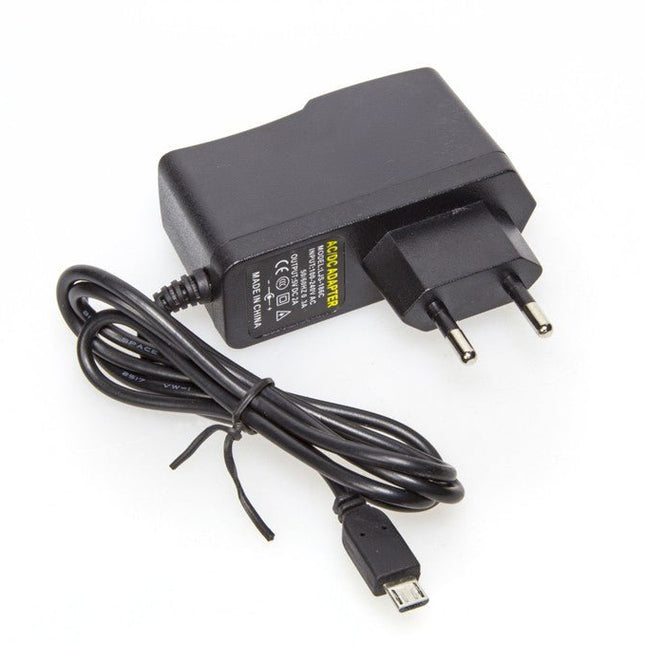
Kuongshun 5 V/2 A Micro-USB Netzteil (EU)
5 V/2 A Micro-USB Netzteil (EU)
€ 7,95
Mitglieder € 7,16
-

The Pi Hut ZeroDock – Prototyping Dock für Raspberry Pi Zero
Die Standardkonfiguration bietet Platz für ein Mini-Breadboard (im Lieferumfang enthalten), einen SD -Kartenadapter, 2x Micro-SD-Karten, 2x USB-Geräte, ein Micro-USB-Shim und natürlich den Raspberry Pi Zero selbst. Der Benutzer kann den Micro-USB-Shim-Steckplatz für einen Micro-HDMI-Adapter verwenden oder eine Portsplus- oder ähnliche GPIO-Referenzkarte in den SD-Adaptersteckplatz stecken. Sie können Ihren USB-Micro-SD-Kartenleser oder sogar andere größere USB-Geräte wie den USBDoctor darin unterbringen. Verwenden Sie es so, wie es für Sie am besten funktioniert. Alle Anschlüsse des Raspberry Pi Zero sind vom ZeroDock aus zugänglich, einschließlich des Kameraanschlusses und der Reset-/Kompositstiftleiste. pHATs werden ebenfalls nicht behindert, so dass Sie mit Ihren bevorzugten Zusatzplatinen Prototypen erstellen können. Das Gehäuse ist eine elegante Mischung aus klaren und schwarzen Acrylschichten, schwarzen Befestigungen und einem klaren Breadboard, das gut zu den meisten Desktop-PCs/Monitoren passt. Eine Anleitung zum Zusammenbau finden Sie hier. Lieferumfang 4 Schichten lasergeschnittenes Acrylgehäuse Gehäuse- und Raspberry Pi-Befestigungen Mini-Breadboard
€ 14,95
Mitglieder € 13,46
-

Elektor Publishing Vintage Radio Equipment
Resonances From Aether Days A Pictorial and Technical Analysis from WWII to the Internet Age From the birth of radio to the late 1980s, much of real life unfolded through shortwave communication. World War II demonstrated—beyond a shadow of a doubt—that effective communications equipment was a vital prerequisite for military success. In the postwar years, shortwave became the backbone on which many of the world's most critical services depended every day. All the radio equipment—through whose cathodes, grids, plates, and transistors so much of human history has flowed—is an exceptional subject of study and enjoyment for those of us who are passionate about vintage electronics. In this book, which begins in the aftermath of World War II, you’ll find a rich collection of information: descriptions, tips, technical notes, photos, and schematics that will be valuable for anyone interested in restoring—or simply learning about—these extraordinary witnesses to one of the most remarkable eras in technological history. My hope is that these pages will help preserve this vast treasure of knowledge, innovation, and history—a heritage that far transcends the purely technical.
€ 79,95
Mitglieder € 71,96
-
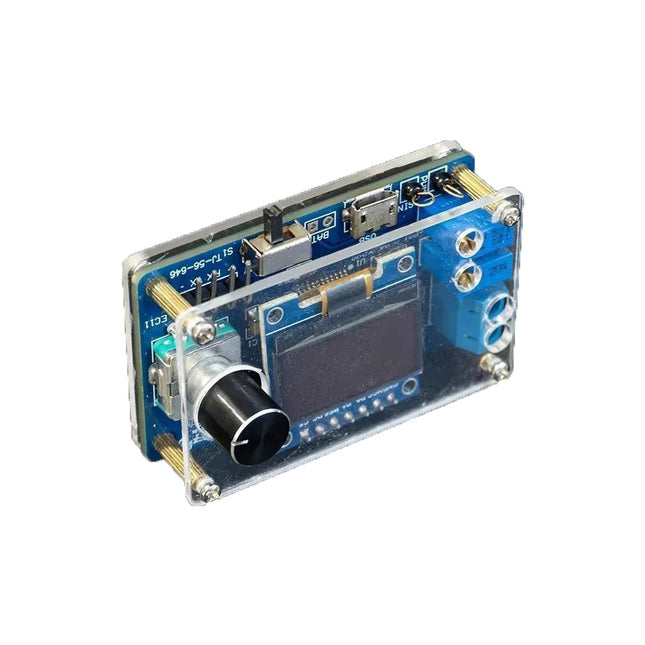
Generic DIY Mini Digital-Oszilloskop-Kit
Das DIY Mini Digital-Oszilloskop-Kit (mit Gehäuse) ist ein einfach zu bauender Bausatz für ein kleines digitales Oszilloskop. Neben dem Netzschalter verfügt es nur über eine weitere Steuerung, einen Drehgeber mit eingebautem Druckknopf. Der Mikrocontroller des Kits ist vorprogrammiert. Das 0,96" OLED-Display hat eine Auflösung von 128 x 64 Pixel. Das Oszilloskop verfügt über einen Kanal, der Signale bis zu 100 kHz messen kann. Die maximale Eingangsspannung beträgt 30 V, die minimale Spannung beträgt 0 V. Das Kit besteht aus Durchgangslochkomponenten (THT) und oberflächenmontierten Bauteilen (SMD). Daher erfordert der Zusammenbau des Bausatzes das Löten von SMD-Teilen, was einige Erfahrung im Löten erfordert. Technische Daten Vertikaler Bereich: 0 bis 30 V Horizontaler Bereich: 100 µs bis 500 ms Triggertyp: Auto, Normal und Single Triggerflanke: Steigend und fallend Triggerpegel: 0 bis 30 V Run/Stop-Modus Automatische Frequenzmessung Stromversorgung: 5 V Micro-USB 10 Hz, 5 V Sinuswellenausgang 9 kHz, 0 bis 4,8 V Rechteckwellenausgang Display: 0,96" OLED-Bildschirm Abmessungen: 57 x 38 x 26 mm Downloads Documentation
€ 19,95€ 9,95
Mitglieder identisch
-
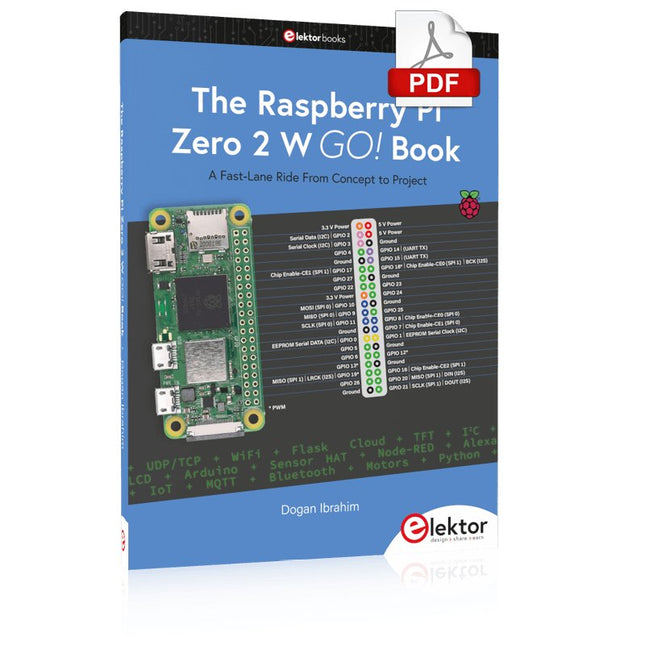
Elektor Digital The Raspberry Pi Zero 2 W GO! Book (PDF)
A Fast-Lane Ride From Concept to Project The core of the book explains the use of the Raspberry Pi Zero 2 W running the Python programming language, always in simple terms and backed by many tested and working example projects. On part of the reader, familiarity with the Python programming language and some experience with one of the Raspberry Pi computers will prove helpful. Although previous electronics experience is not required, some knowledge of basic electronics is beneficial, especially when venturing out to modify the projects for your own applications. Over 30 tested and working hardware-based projects are given in the book, covering the use of Wi-Fi, communication with smartphones and with a Raspberry Pi Pico W computer. Additionally, there are Bluetooth projects including elementary communication with smartphones and with the popular Arduino Uno. Both Wi-Fi and Bluetooth are key features of the Raspberry Pi Zero 2 W. Some of the topics covered in the book are: Raspberry Pi OS installation on an SD card Python program creation and execution on the Raspberry Pi Zero 2 W Software-only examples of Python running on the Raspberry Pi Zero 2 W Hardware-based projects including LCD and Sense HAT interfacing UDP and TCP Wi-Fi based projects for smartphone communication UDP-based project for Raspberry Pi Pico W communication Flask-based webserver project Cloud storage of captured temperature, humidity, and pressure data TFT projects Node-RED projects Interfacing to Alexa MQTT projects Bluetooth-based projects for smartphone and Arduino Uno communications
€ 32,95
Mitglieder € 26,36
-
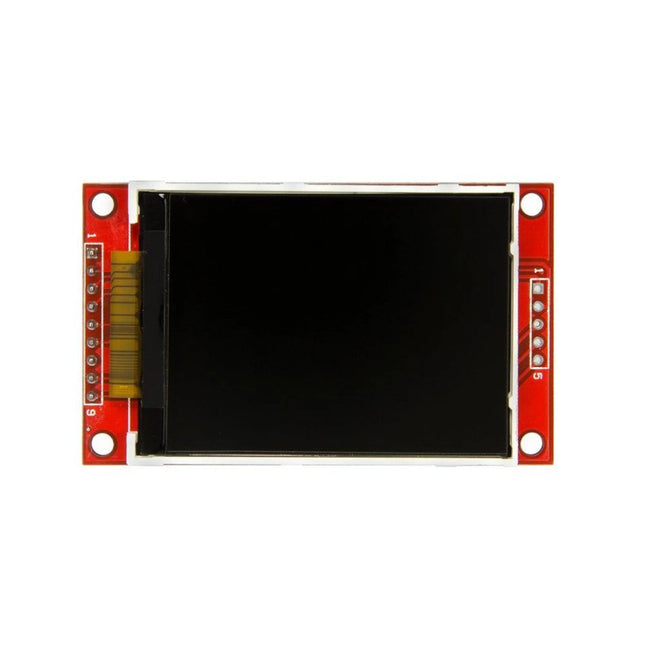
Kuongshun 2,2-Zoll-SPI-TFT-Anzeigemodul ILI9341 (240 x 320)
ILI9341 ist ein 262144-Farben-Einzelchip-SOC-Treiber für ein TFT-Flüssigkristalldisplay mit einer Auflösung von 240 x 320 Punkten (RGB), bestehend aus einem 720-Kanal-Source-Treiber, einem 320-Kanal-Gate-Treiber und 172800 Byte GRAM für Grafikanzeigedaten von 240 x 320 Punkte (RGB) und Stromversorgungsschaltung. ILI9341 unterstützt parallele 8-/9-/16-/18-Bit-Datenbus-MCU-Schnittstellen, 6-/16-/18-Bit-Datenbus-RGB-Schnittstellen und 3-/4-Leiter-Seriell-Peripherieschnittstellen (SPI). Der Bewegtbildbereich kann im internen GRAM durch die Fensteradressenfunktion angegeben werden. Der angegebene Fensterbereich kann selektiv aktualisiert werden, sodass bewegte Bilder unabhängig vom Standbildbereich gleichzeitig angezeigt werden können. ILI9341 kann mit einer Schnittstellenspannung von 1,65 V ~ 3,3 VI/O und einer integrierten Spannungsfolgerschaltung betrieben werden, um Spannungspegel für die Ansteuerung eines LCD zu erzeugen. Der ILI9341 unterstützt den Vollfarb-, 8-Farben-Anzeigemodus und den Schlafmodus für eine präzise Leistungssteuerung per Software. Diese Funktionen machen den ILI9341 zu einem idealen LCD-Treiber für mittelgroße oder kleine tragbare Produkte wie digitale Mobiltelefone, Smartphones, MP3 und PMP, wo lange Die Akkulaufzeit ist ein großes Problem. Merkmale Bildschirmauflösung: 240 x 320 (RGB) Ausgabe: 720 Quellausgänge | 320 Gate-Ausgänge | Gemeinsamer Elektrodenausgang (VCOM) a-TFT-LCD-Treiber mit On-Chip-Vollanzeige-RAM: 172.800 Byte Systemschnittstelle 8-Bit-, 9-Bit-, 16-Bit-, 18-Bit-Schnittstelle mit MCU der Serie 8080-Ⅰ/8080-Ⅱ 6-Bit-, 16-Bit-, 18-Bit-RGB-Schnittstelle mit Grafikcontroller 3-zeilige / 4-zeilige serielle Schnittstelle Anzeigemodus: Vollfarbmodus (Leerlaufmodus AUS): 262K Farbe Reduzierter Farbmodus (Leerlaufmodus EIN): 8 Farben Energiesparmodi: Schlafmodus Deep-Standby-Modus On-Chip-Funktionen: VCOM-Generator und -Anpassung Timing-Generator Oszillator DC / DC-Wandler Linien-/Rahmenumkehr 1 voreingestellte Gammakurve mit separater RGB-Gammakorrektur Inhaltsadaptive Helligkeitssteuerung MTP (3-mal): 8 Bit für ID1, ID2, ID3 7-Bit für VCOM-Anpassung Architektur mit geringem Stromverbrauch Niedrige Betriebsstromversorgungen: VDDI = 1,65 V ~ 3,3 V (Logik) VCI = 2,5 V ~ 3,3 V (analog) LCD-Spannungsantrieb: Quelle/VCOM-Versorgungsspannung AVDD – GND = 4,5 V ~ 5,5 V VCL - GND = -2,0 V ~ -3,0 V Ausgangsspannung des Gate-Treibers VGH - GND = 10,0 V ~ 20,0 V VGL - GND = -5,0 V ~ -15,0 V VGH - VGL 3 ≦ 2V Ausgangsspannung des VCOM-Treibers VCOMH = 3,0 V ~ (AVDD – 0,5) V VCOML = (VCL+0,5)V ~ 0V VCOMH – VCOML ≦ 6,0 V Betriebstemperaturbereich: -40℃ bis 85℃
€ 22,95
Mitglieder € 20,66
-
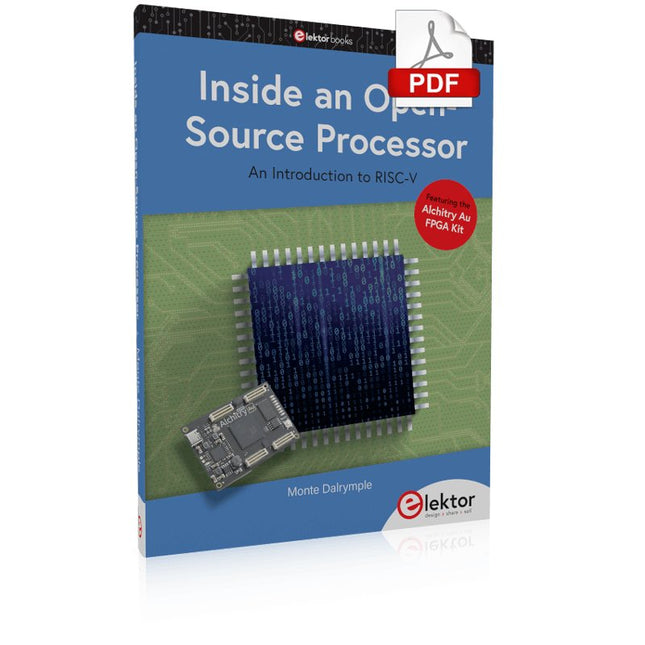
Elektor Digital Inside an Open-Source Processor (E-book)
An Introduction to RISC-V RISC-V is an Instruction Set Architecture (ISA) that is both free and open. This means that the RISC-V ISA itself does not require a licensing fee, although individual implementations may do so. The RISC-V ISA is curated by a non-profit foundation with no commercial interest in products or services that use it, and it is possible for anyone to submit contributions to the RISC-V specifications. The RISC-V ISA is suitable for applications ranging from embedded microcontrollers to supercomputers. This book will first describe the 32-bit RISC-V ISA, including both the base instruction set as well as the majority of the currently-defined extensions. The book will then describe, in detail, an open-source implementation of the ISA that is intended for embedded control applications. This implementation includes the base instruction set as well as a number of standard extensions. After the description of the CPU design is complete the design is expanded to include memory and some simple I/O. The resulting microcontroller will then be implemented in an affordable FPGA development board (available from Elektor) along with a simple software application so that the reader can investigate the finished design.
€ 32,95
Mitglieder € 26,36
-
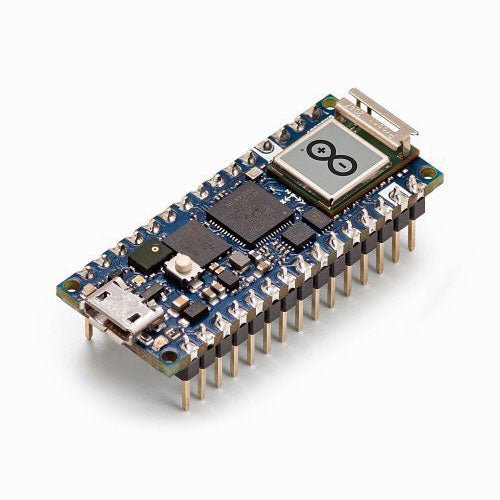
Arduino Arduino Nano RP2040 Connect (mit Header)
Der Arduino Nano RP2040 Connect ist ein RP2040-basiertes Arduino-Board, das mit Wi-Fi (802.11b/g/n) und Bluetooth 4.2 ausgestattet ist. Neben der drahtlosen Konnektivität verfügt es über ein Mikrofon für Sound und Sprachaktivierung und einen 6-achsigen intelligenten Bewegungssensor mit KI-Fähigkeiten. Über 22 GPIO-Ports lassen z. B. Relais, Motoren und LEDs steuern sowie Schalter und andere Sensoren auslesen. Programmspeicher ist mit 16 MB Flash-Speicher reichlich vorhanden, mehr als genug Platz, um viele Webseiten oder andere Daten zu speichern. Technische Daten Mikrocontroller Raspberry Pi RP2040 USB-Anschluss Micro USB Pins Built-in LED-Pins 13 Digitale I/O-Pins 20 Analoge Input-Pins 8 PWM-Pins 20 (Except A6, A7) Externe Interrupts 20 (Except A6, A7) Konnektivität Wi-Fi Nina W102 uBlox Modul Bluetooth Nina W102 uBlox Modul Sicheres Element ATECC608A-MAHDA-T Crypto IC Sensoren IMU LSM6DSOXTR (6-achsig) Mikrofon MP34DT05 Kommunikation UART Yes I²C Yes SPI Yes Stromversorgung Schaltungsbestriebsspannung 3,3 V Eingangsspannung (VIN) 5-21 V DC-Strom pro I/O-Pin 4 mA Taktgeschwindigkeit Prozessor 133 MHz Speicher AT25SF128A-MHB-T 16 MB Flash IC Nina W102 uBlox Modul 448 KB ROM, 520 KB SRAM, 16 MB Flash Länge 45 x 18 mm Gewicht 6 g Downloads Schaltplan Pinout Datenblatt
€ 29,95€ 14,95
Mitglieder identisch
-

OWON OWON HDS160 (2-in-1) True RMS Multimeter & Oszilloskop
Das OWON HDS160 ist ein präzises 4½-stelliges True RMS Multimeter (60000 Counts), ideal für Elektronikprofis, Maker und Studenten. Es bietet eine intelligente Sondenerkennung, automatische Wellenformmessungen (Vmax, Vmin, Vp-p, Vavg, Vrms und Frequenz) und ein voll ausgestattetes Handoszilloskop (1 MHz). Features Multifunktionales Messgerät: 4½-stelliges Multimeter + Oszilloskop Automatische Wellenformmessungen: Einschließlich Vmax, Vmin, Vp-p, Vavg, Vrms und Frequenz. Benutzerfreundliches Design: Klar beschriftete Tasten für einfache Bedienung und längere Gerätelebensdauer. Intelligente Sondenerkennung: Schaltet automatisch die Messfunktionen basierend auf dem Einführen der Sonde um und verhindert so effektiv Geräteschäden durch falsche Bedienung. Effizientes Energiemanagement: Angetrieben durch 18650-Lithiumbatterien, die längere Betriebszeit und verbesserte Zuverlässigkeit für erweiterte Messaufgaben gewährleisten. Sichere Hochspannungsmessung: Entspricht den CAT Ⅲ 1000 V-Standards und ermöglicht eine sichere und direkte Messung von Hochspannungswellenformen bis zu 1000 V, erweitert die Anwendungsmöglichkeiten. Hochauflösendes Display: Verfügt über einen 2,8" IPS-Bildschirm mit weitem Betrachtungswinkel, der eine klare Lesbarkeit aus jeder Perspektive gewährleistet. Adaptives Umgebungsdisplay: Dual-Theme-Displaymodi mit hoher Helligkeit und hohem Kontrast bieten optimale Sichtbarkeit bei hellen und schlechten Lichtverhältnissen und verbessern die allgemeine Benutzerfreundlichkeit. Multimeter (Technische Daten) Messbereich Genauigkeit Gleichspannung (V) 60.000mV / 600.00mV / 6.0000V / 60.000V / 600.00V / 1000.0V ±(0.05%+5 dig) Wechselspannung (V) 60.000mV / 600.00mV / 6.0000V / 60.000V / 600.00V / 750.00V ±(0.1%+30dig) Gleichstrom (A) 600.00uA / 6000.0uA / 60.000mA / 600.00mA / 6.0000A / 10.000A ±(0.15%+10dig) Wechselstrom (A) 600.00uA / 6000.0uA / 60.000mA / 600.00mA / 6.0000A / 10.000A ±(0.5%+20dig) Widerstand (Ω) 600.00Ω / 6.0000kΩ / 60.000kΩ / 600.00KΩ / 6.0000MΩ / 60.000MΩ ±(0.15%+10dig) Kapazität (F) 6.000nF / 60.00nF / 600.0nF / 6.000μF / 60.00μF / 600.0μF / 6.000mF / 60.00mF ±(2.0%+20dig) Frequenz (Hz) 60.00Hz / 600.00Hz / 6.0000kHz / 60.000kHz / 600.00kHz / 6.0000MHz / 60.000MHz ±(0.2%+10dig) Arbeitszyklus 0.1%~99.9% (typischer Wert: Vrms=1V, f=100Hz) ±(1.2%+3dig) 0.1%~99.9% (≥1kHz) ±(2.5%+10dig) Diode 3.0000V ±(1.0%+10dig) On-Off 1000.0Ω Display 60000 Oszilloskop (Technische Daten) Analoge Bandbreite 1 MHz (nur ACV-Skala) Kanal 1 Zeitbasisbereich 2,5 µs~10 s/Raster Vertikaler Spannungsempfindlichkeitsbereich 30 mV~500 V/Raster Vertikale Amplitudengenauigkeit ±(5%+0,2 div) Maximale Spannungsgrenze 1000 V DC+AC Peak Wert Triggermodus Auto/Normal/Single Automatische Einstellung Zeitbasis/Vertikale Amplitude/Triggerwert Maximale Abtastung 5,0 MSa/s Eingangsimpedanz ≈10 MΩ Zeitbasisgenauigkeit ±(0,01% + 0,1 div) Aktueller vertikaler Empfindlichkeitsbereich 100 μA~5 A/Gitter Messfunktion Vmax, Vmin, Vp-p, Vavg, Vrms, Hz Maximale Strombegrenzung 15 A DC+AC Spitzenwert Triggerflanke Rise edge/Fall edge Allgemein (Technische Daten) Display 2,8" LCD (320 x 240) Batteriestandsanzeige Ja Hintergrundbeleuchtung Ja Ruhemodus Ja Eingangsschutz Ja Relative Messung Ja Eingangsimpedanz ≥10 MΩ Batterie 18650 Lithium Sicherheitskonformität CAT III 1000 V Abmessungen 93 x 41,5 x 188 mm Gewicht 0,35 kg Lieferumfang 1x OWON HDS160 Multimeter & Oszilloskop 2x Multimeterkabel 1x USB-Kabel 1x Aufbewahrungstasche 1x Manual Downloads Datasheet Manual
€ 83,60
-
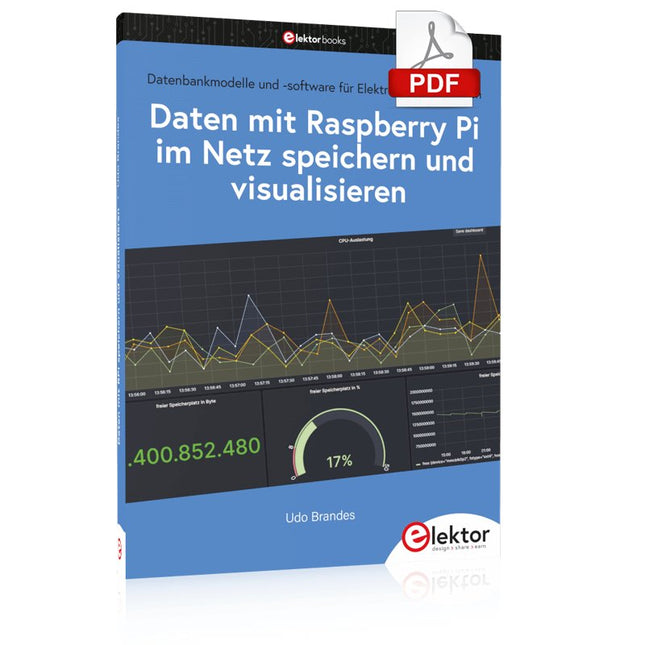
Elektor Digital Daten mit dem Raspberry Pi im Netz speichern und visualisieren (PDF)
Datenbankmodelle und -software für Elektronikanwendungen Mit seiner Energieeffizienz und seinem reichen Spektrum an quelloffener Software eignet sich der Einplatinencomputer Raspberry Pi auch für die Speicherung von Daten und deren grafische Aufbereitung lokal oder im World Wide Web (WWW). Dieses Buch stellt verschiedene Datenbankmodelle und diverse Datenbanksoftware vor: SQL: MariaDB, SQLite InfluxDB: Telegraf Grafana MQTT Verschlüsselung mit RPi Apache PHP Node RED Docker Es zeigt darüber hinaus ausgewählte Ansätze, gespeicherte Daten anzuzeigen und zu verwalten. Ein eigener Abschnitt ist sowohl der SSL-Verschlüsselung der Verbindung als auch dem Betrieb von Servern im WWW gewidmet. Das Buch richtet sich an alle, die neugierig sind und gerne die Möglichkeiten des Raspberry Pi ausloten möchten, die einen Einstieg in das Datenmanagement mit Datenbanken suchen, die mit einfachen Mitteln schnell loslegen möchten, die Alternativen aufgezeigt bekommen möchten, die in komprimierter Form Tipps für eigene Entwicklungen suchen, die Freude am eigenen Entwickeln und Realisieren haben. Programmierkenntnisse und -erfahrungen sind für die Installation der Software nicht erforderlich. Jeder einzelne Schritt wird detailliert beschrieben und mit Screenshots visuell unterlegt.
€ 29,80
Mitglieder € 23,84
-

Elektor Publishing Acoustics in Performance
All you need to know about good acoustics and sound systems in performance and worship spaces! Everyone knows that the ability to hear music in balance and to understand speech is essential in any space used for performance or worship. Unfortunately, in the early 21st century, we find that buildings with good acoustics are the exception rather than the rule. Much of the fault leading to this result can be traced to the widespread perception that acoustics is a black art. In fact, scientific acoustics as developed in the last century is a well-defined engineering practice that can lead to predictable excellent results. A basic, non-engineering understanding of acoustics will help building owners, theater managers, ministers and teachers of music, performers, and other professionals to achieve their goals of excellent acoustics in venues with which they work. Performers having a basic understanding of acoustics will be able to make the most of the acoustics of the venue in which they perform. This book helps those responsible for providing good acoustics in performance and worship spaces to understand the variables and choices entailed in proper acoustic design for performance and worship. Practicing acoustical consultants will find the book a useful reference as well. The level of presentation is comfortable and straightforward without being simplistic. If correct acoustical principles are incorporated into the design, renovation, and maintenance of performance and worship venues, good acoustics will be the result.
€ 29,95
Mitglieder € 26,96
-

Elektor Publishing Innovate with Sense HAT for Raspberry Pi
Ready to explore the world around you? By attaching the Sense HAT to your Raspberry Pi, you can quickly and easily develop a variety of creative applications, useful experiments, and exciting games. The Sense HAT contains several helpful environmental sensors: temperature, humidity, pressure, accelerometer, magnetometer, and gyroscope. Additionally, an 8x8 LED matrix is provided with RGB LEDs, which can be used to display multi-color scrolling or fixed information, such as the sensor data. Use the small onboard joystick for games or applications that require user input. In Innovate with Sense HAT for Raspberry Pi, Dr. Dogan Ibrahim explains how to use the Sense HAT in Raspberry Pi Zero W-based projects. Using simple terms, he details how to incorporate the Sense HAT board in interesting visual and sensor-based projects. You can complete all the projects with other Raspberry Pi models without any modifications. Exploring with Sense HAT for Raspberry Pi includes projects featuring external hardware components in addition to the Sense HAT board. You will learn to connect the Sense HAT board to the Raspberry Pi using jumper wires so that some of the GPIO ports are free to be interfaced to external components, such as to buzzers, relays, LEDs, LCDs, motors, and other sensors. The book includes full program listings and detailed project descriptions. Complete circuit diagrams of the projects using external components are given where necessary. All the projects were developed using the latest version of the Python 3 programming language. You can easily download projects from the book’s web page. Let’s start exploring with Sense HAT.
€ 34,95
Mitglieder € 31,46
-

Elektor Publishing Renewable Energy at Home
A Hands-on Guide to Crafting Your Own Power Plant The book you are about to read provides a step-by-step guide for building a renewable energy power plant at home. Our goal was to make the book as practical as possible. The material is intended for immediate application with a small amount of theory. Yet, the theory is important as a foundation that saves time and effort by disabusing the readers of potential misconceptions. Specifically, upon having a firm understanding of photovoltaic physics, you will not be inclined to fruitlessly search for 90% efficient solar panels! We want our readers to be the “doers”. If the book gets covered in grime and some pages become torn while you are building your power plant – this is the best compliment to us. The book covers solar and wind energy. Also, a curious power source based on manure is discussed as well, giving the doers an opportunity to further develop the manure fuel cell. It is important to note that there are many companies offering installation of complete solar solutions. Upon installing the panels, the system is not owned by the customer. Therefore, there is no freedom for experimentation and optimization. Also, none can beat the cost of a DIY solution as well as the ultimate satisfaction. All that is written here is a result of us building a renewable energy solution in Southern California. As the book was completed, the energy began flowing!
€ 29,95
Mitglieder € 26,96
-
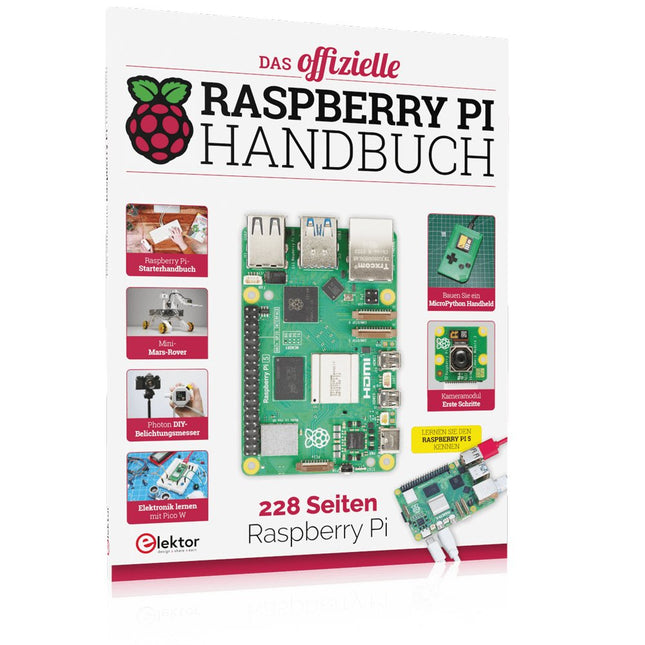
Elektor Publishing Das offizielle Raspberry Pi Handbuch
Von den Machern von MagPi, dem offiziellen Raspberry Pi Magazin Starten Sie jetzt mit dem Raspberry Pi 5, dem neuesten und besten Minicomputer von Raspberry Pi – und lernen Sie, mit diesem unglaublichen Computer zu programmieren und Projekte zu erstellen. In diesem Buch finden Sie außerdem jede Menge kreative Ideen und Tipps, die Sie mit dem Raspberry Pi 4, dem Raspberry Pi Zero 2 W und dem Raspberry Pi Pico W umsetzen können. Mit den neuesten Reviews, Tutorials, Projekten, Anleitungen und mehr ist dies Ihre ultimative Ressource für den Raspberry Pi! 228 Seiten über Raspberry Pi Alles, was Sie über den Raspberry Pi 5 wissen müssen Erste Schritte für jeden Raspberry Pi Viel Spaß mit Elektronik und dem Pico W Inspirierende Projekte für Ihre nächste Bauidee Lernen Sie MicroPython, indem Sie ein Handheld bauen Erste Schritte mit dem Raspberry Pi Kamera Modul Künstliche Intelligenz: Bauen Sie Ihren eigenen GPT Chatbot
€ 34,80
Mitglieder identisch
-

Zhongdi Entlötspitzen-Set für ZD-Modelle
Dieses Set enthält 3 Entlötspitzen für digitale Entlötstationen wie ZD-915 oder ZD-8965. Lieferumfang 1x Entlötspitze N5-1 (0,8 mm) 1x Entlötspitze N5-2 (1,0 mm) 1x Entlötspitze N5-3 (1,3 mm)
€ 9,95
Mitglieder € 8,96
-

Elektor Publishing KiCad Like A Pro – Advanced Projects and Recipes
Mastering PCB design with real-world projects This book builts on KiCad Like a Pro – Fundamentals and Projects and aims to help you practice your new KiCad skills by challenging you in a series of real-world projects. The projects are supported by a comprehensive set of recipes with detailed instructions on how to achieve a variety of simple and complex tasks. Design the PCBs for a solar power supply, an LED matrix array, an Arduino-powered datalogger, and a custom ESP32 board. Understand the finer details of the interactive router, how to manage KiCad project teams with Git, how to use an autorouter on 2 and 4-layer PCBs, and much more. KiCad 8 is a modern, cross-platform application suite built around schematic and design editors. This stable and mature PCB tool is a perfect fit for electronic engineers and makers. With KiCad 8, you can create PCBs of any complexity and size without the constraints associated with the commercial packages. Here are the most significant improvements and features in KiCad 8, both over and under the hood: Modern user interface, completely redesigned from earlier versions Improved and customizable electrical and design rule checkers Theme editor allowing you to fully customize the look of KiCad on your screen Ability to import projects from Eagle, CADSTART, and more An improved and tightly integrated SPICE circuit simulator Autorouting with the Freerouting plugin Filters define which elements of a layout are selectable Enhanced interactive router helps you draw single tracks and differential pairs with precision New or enhanced tools to draw tracks, measure distances, tune track lengths, etc. Enhanced tool for creating filled zones A customizable coordinate system facilitates data exchange with other CAD applications Realistic ray-tracing capable 3D viewer Differential pair routing Rich repositories of symbol, footprint, and 3D shape libraries Python scripting API for programmatic customization and extensions Improved footprint wizard for fast custom footprints
€ 49,95
Mitglieder € 44,96
-
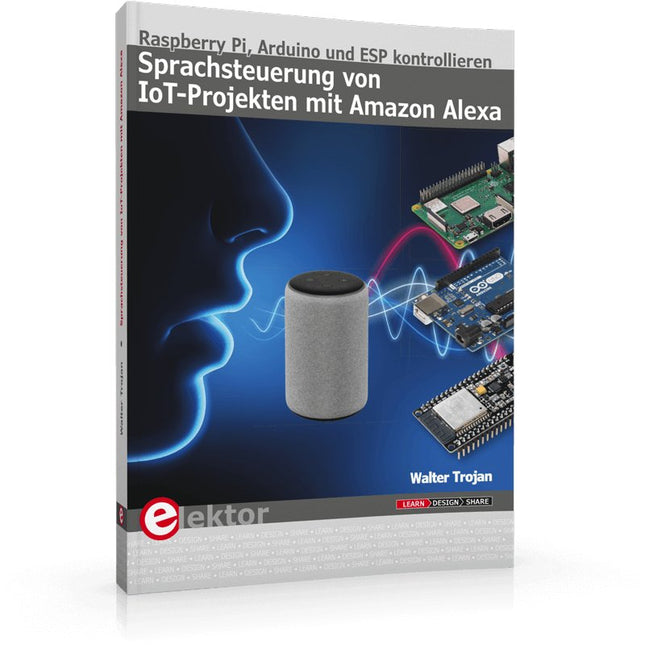
Elektor Publishing Sprachsteuerung von IoT-Projekten mit Amazon Alexa
Sprachsteuerung von IoT-Projekten mit Amazon Alexa gibt dem Leser einen tiefen Einblick in die Technik der Sprachsteuerung am Beispiel von Amazon Alexa. Es erklärt detailliert Schritt für Schritt, wie man Raspberry Pi, ESP8266/32 und Arduino mit einem Sprachassistenten verbindet und steuert. Dieses geschieht anhand von Projekten aus den Bereichen Hausautomation und Robotik. Der Leser erfährt, wie man Heizkessel, Roboter und Gartenhäuser mit dieser modernen Mensch-Maschine-Schnittstelle kommandieren kann. Der Autor Walter Trojan führt dabei den Leser in die vielschichtige Welt der Amazon Web Services ein, wo er neben dem Alexa Skills Kit weitere Module wie AWS Lambda und IoT Core kennenlernt. Das erwartet den Leser: Kapitel 1: Sprachassistenten setzen sich durch Kapitel 2: Alexa intern Kapitel 3: Der erste Alexa Skill Kapitel 4: Alexa Skills für Fortgeschrittene Kapitel 5: Erster Hardware-Skill auf Raspberry Pi Kapitel 6: Auch Alexa liebt die Arduino-IDE Kapitel 7: Hacks mit Schaltern Kapitel 8: Alexa steuert ein Gartenhaus Kapitel 9: Auch Roboter gehorchen Alexa Kapitel 10: Alexa geht fremd
€ 39,80
Mitglieder identisch
-

Elektor Publishing MSP430 Microcontroller Essentials
Architecture, Programming and Applications The MSP430 is a popular family of microcontrollers from Texas Instruments. In this book we will work with the smallest type, which is the powerful MSP430G2553. We will look at the capabilities of this microcontroller in detail, as it is well-suited for self-made projects because it is available in a P-DIP20 package. We will take a closer look at the microcontroller and then build, step by step, some interesting applications, including a 'Hello World' blinking LED and a nice clock application, which can calculate the day of the week based on the date. You also will learn how to create code for the MSP microcontroller in assembler. In addition to that, we will work with the MSP-Arduino IDE, which makes it quite easy to create fast applications without special in-depth knowledge of the microcontrollers. All the code used in the book is available for download from the Elektor website.
€ 39,95
Mitglieder € 35,96
-
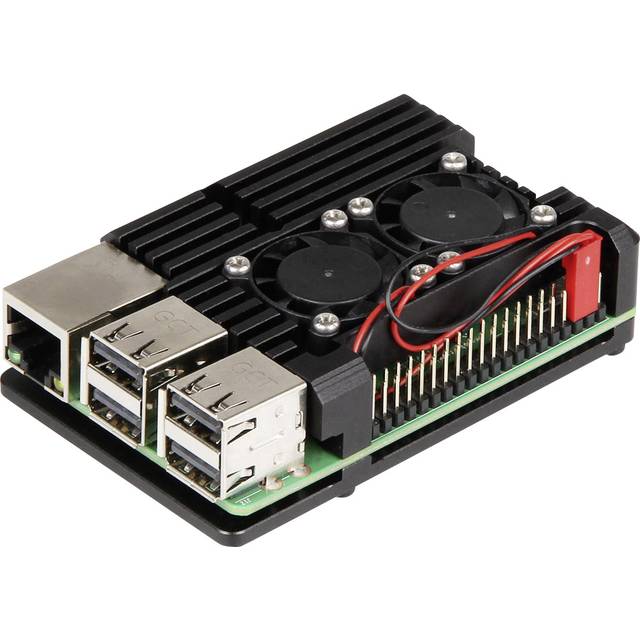
JOY-iT JOY-iT Armor Aluminium-Kühlkörpergehäuse mit Doppellüfter für Raspberry Pi 4
Dieses auf Aluminium basierende Armor Case ist perfekt für Ihren Raspberry Pi 4, wenn er heiß wird, denn es schützt ihn gleichermaßen vor Stößen und Hitze. Die Kanalfräsung kombiniert mit zwei Lüftern bietet beste Kühlleistung. Deshalb ist es auch für extreme Bedingungen geeignet. Ein weiterer Vorteil ist, dass dieses Gehäuse nicht mehr Platz benötigt als der Raspberry Pi selbst und in bestehende Projekte integriert werden kann. Merkmale Material: CNC-gefräste Aluminiumlegierung Kompatibel mit Raspberry Pi 4B Zusammenbau: 4 mitgelieferte Schrauben verbinden das Gehäuse mit dem Raspberry Pi Besonderheiten: Großer Kühlkörper und Doppellüfter mit je Ø24 mm, massiver Schutz gegen Hitze und Erschütterungen, kein zusätzlicher Platzbedarf Verkabelung: Lüfter 5V (Rot) - 5V (Pin4), Lüfter GND (Schwarz) - GND (Pin6) Lieferumfang: Panzergehäuse "BLOCK ACTIVE", Schrauben, Wärmeleitband Größe Oberseite: 69 x 56 x 15,5 mm Größe Unterseite: 87 x 56 x 7,5 mm Downloads Handbuch
€ 17,95€ 15,95
Mitglieder identisch
-

FTDI FTDI Serielles TTL-RS232-USB-Kabel
Dieses FTDI USB zu TTL (3,3 V I/O) Serielle Kabel (FTDI TTL-232R-3V3 OEM) ist ein professionelles, hochwertiges und schnelles Gerät, das eine einfache und bequeme Möglichkeit bietet, TTL-Schnittstellengeräte über einen freien USB-Anschluss anzuschließen. Funktionen TTL-232R-3V3 FTDI USB zu TTL 3,3 V Serielles Kabel FTDI TTL-232R-3V3 Kabel 6-fach Das FTDI USB zu TTL 3,3 V verfügt über ein integriertes FTDI FT232R-Gerät im Kabel FTDI USB zu TTL Serieller 3,3 V Adapterkabel 6-poliger 0,1"-Buchsenstecker UART IC FT232RL-Chip Kompatibel mit Windows 7/8/10 und Linux
€ 19,95
Mitglieder € 17,96
-
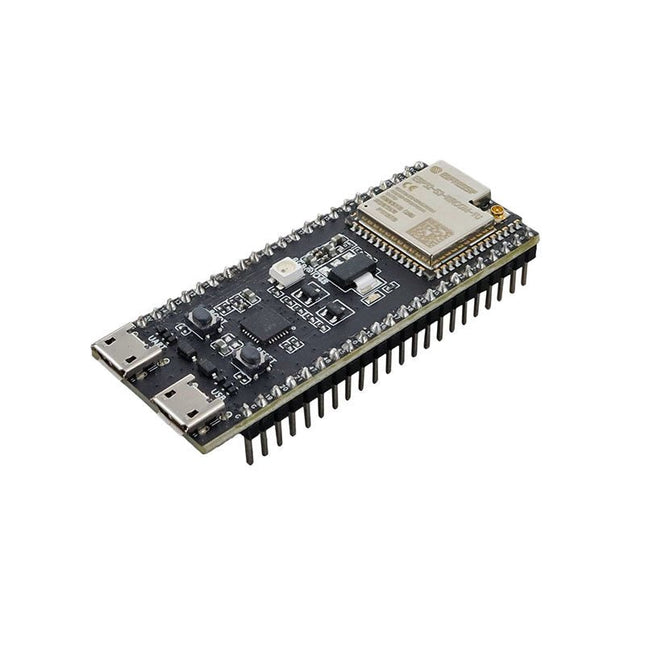
Espressif ESP32-S3-DevKitC-1U-N8R8
Das ESP32-S3-DevKitC-1 ist ein Entwicklungsboard der Einstiegsklasse, das mit dem ESP32-S3-WROOM-1U ausgestattet ist, einem universellen Wi-Fi + Bluetooth Low Energy MCU-Modul, das vollständige Wi-Fi- und Bluetooth Low Energy-Funktionen integriert. Die meisten E/A-Pins des Moduls sind auf die Stiftleisten auf beiden Seiten des Boards verteilt, um eine einfache Anbindung zu ermöglichen. Entwickler können entweder Peripheriegeräte mit Jumper-Drähten anschließen oder ESP32-S3-DevKitC-1 auf einem Breadboard montieren. Features Integriertes Modul: ESP32-S3-WROOM-1U-N8R8 Flash: 8 MB QD PSRAM: 8 MB OT SPI-Spannung: 3,3 V Technische Daten ESP32-S3-WROOM-1U ESP32-S3-WROOM-1U ist ein leistungsstarkes, generisches Wi-Fi + Bluetooth Low Energy MCU-Modul, das über eine umfangreiche Auswahl an Peripheriegeräten verfügt. Es bietet Beschleunigung für neuronale Netzwerk-Computing- und Signalverarbeitungs-Workloads. ESP32-S3-WROOM-1U wird mit einem externen Antennenanschluss geliefert. 5 V bis 3,3 V LDO Leistungsregler, der eine 5-V-Versorgung in einen 3,3-V-Ausgang umwandelt. Pin-Header Alle verfügbaren GPIO-Pins (mit Ausnahme des SPI-Busses für Flash) sind zur einfachen Anbindung und Programmierung auf die Pin-Header auf der Platine verteilt. USB-zu-UART-Anschluss Ein Micro-USB-Anschluss, der für die Stromversorgung der Platine, für Flash-Anwendungen auf dem Chip sowie für die Kommunikation mit dem Chip über die integrierte USB-zu-UART-Brücke verwendet wird. Boot-Schaltfläche Herunterladen-Schaltfläche. Wenn Sie „Boot“ gedrückt halten und dann „Reset“ drücken, wird der Firmware-Download-Modus zum Herunterladen von Firmware über die serielle Schnittstelle gestartet. Reset-Taste Drücken Sie diese Taste, um das System neu zu starten. USB-Anschluss ESP32-S3 Full-Speed-USB-OTG-Schnittstelle, kompatibel mit der USB 1.1-Spezifikation. Die Schnittstelle wird zur Stromversorgung des Boards, zum Flashen von Anwendungen auf dem Chip, zur Kommunikation mit dem Chip über USB 1.1-Protokolle sowie zum JTAG-Debugging verwendet. USB-zu-UART-Brücke Ein einzelner USB-zu-UART-Bridge-Chip bietet Übertragungsraten von bis zu 3 Mbit/s. RGB-LED Adressierbare RGB-LED, gesteuert durch GPIO38. 3,3 V Power-On-LED Schaltet sich ein, wenn die USB-Stromversorgung an die Platine angeschlossen ist. Downloads Pinout
€ 29,95€ 14,95
Mitglieder identisch
-

Elektor Digital Consumer Electronics Repair, Reuse and Recycling (E-book)
A Combat Guide against E-waste and Throwawayism This book is for anyone who enjoys tinkering with analog and digital hardware electronics. Regardless of the sophistication of your workspace, only basic tools are required to achieve truly satisfying results. It is intended as a reference guide among other hardware repair publications you may have in your library. However, the book goes a step further than most other repair guides in addressing issues in the modern era of discarded electronics called e-waste. E-waste should be put to good use. Producing anything new requires not just precious resources and labor, but also energy to make and deliver it to global retail shelves. Your talents and love of electronics can be put to good use by rescuing and resurrecting at least selected units from this endless stream of e-waste. Examples include either restoring through repair, or salvaging reusable electronic and mechanical components for your next project. Smart tips are provided throughout the book, and much information is tabulated for easy reference. The book expands age-old repair and hacking techniques applied for repair on the workbench into clever methods and applications to achieve effective results with discarded or “non-servicable” electronic consumer products. The final chapter provides real-life examples using all of the previously discussed content in a summarized form for each example repair type.
€ 32,95
Mitglieder € 26,36























